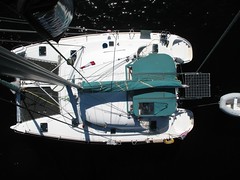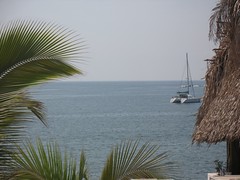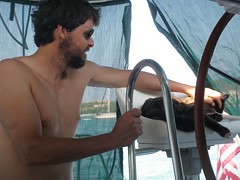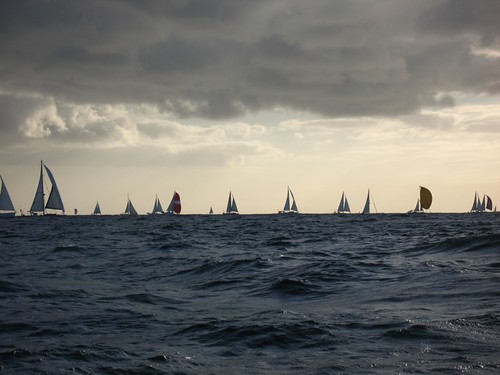I slam the book down on the table, frustrated beyond measure. "This is no good. I can't figure out what the hell they mean."
DrC mumbles something supportive but wholly incoherent.
There is the sound of stataco typing as I bang away at the laptop for a few minutes punctuated periodically by, "Yes... yes!... YES!!!"
Now DrC looks up. In retrospect, I suppose my vocalizations were suspiciously similar to something more interesting to DrC than immigration regulations. "You okay?"
I nod vigoursly and start copying and pasting like a mad fiend. "Two '10 jumpers blogged it."
DrC's eyes narrow as he parses this out, "Two of the boats puddle jumping this year wrote about the immigration requirements in their blogs."
"Uh huh."
"But how do you know it's true?" he asks.
This stops me absolutely cold. After 20 years, there are few moments in which I feel that my husband and I are not in sync. Even rarer are there times where I feel the man is living on a completley different plant. And now, here in this little kitchen in suburban New Zealand, existence shimmers like a Scobby retrospective into two distinctive planes of existence. In one, research is conducted in libraries and with government agencies. Academics and intellectuals ponder the evidence, write their results, and dispense their knowledge in academic journals and printed books.
And then there is where I live.
In the world I live in, the wisdom of the crowds is almost inevitably better than the research of any individual. This is the world of Wikipedia, Yelp, Facebook, Digg, slash dot and Twitter. This is a place where when I want a Word template for product planning, I can simply ask the hivemind, and four arrive within the hour in my inbox. Now that doesn't mean the crowd is always right. The crowd can make monumental errors; lolcats comes to mind. It also doesn't mean that you should take as writ that everything you read on Wikipedia is correct. It's not. We all know that. However, I'd take a Wiki entry over most static books as a starting point. Start poking the referenced resources at the bottom of the entry, and now you're getting to some serious solid research.
I'd also take a blog entry from a fellow cruiser over a 10 year old cruising guide. Every time.
It's not the author's fault. I find the whole concept of cruising guide authorship challenging at best. Even if the area about which you are writing is your favorite haunting ground, there is no practical way to visit each marina and anchorage every year to update the book. For parts of the world that are practical to visit only as a way point on a much longer, non-replicable journey, such as crossing the South Pacific or transiting the Panama Canal, there is no way at all that the author can maintain the accuracy of the content. Sure, the charts may stay essentially the same. Information about the facilities, paperwork, or local ameneties are too fluid to maintain.
This is why I have been monitoring with such glee the introduction of tools such as Active Captain and Wikitravel. I really want these efforts to succeed. There are, however, two problems with these resources:
* South Pacific - So far, no one has really started contributing to the South Pacific part of the map. Since this is where we are going, I feel like we're stuffed.
* Portability - Neither company/project has come up with a way to copy the entire database down to a local laptop, let alone print the relevant bits. Cruisers halfway across the Pacific have lousy Internet access.
So here I am, pouring over the three "must have" cruising guides for our Puddle Jump, and at least once every 10 minutes I slam them down on the table and retreat to Google. And when I can't get my question answered by the experts, I find that Quest or Tenaya or Ken and Cathy answered it. Browsing the blogs of this year's jumpers, I'm able to answer even the most changeable, challenging questions. All it requires is hours and hours of browsing, reading, trolling, and googling. And a constant connection to the Internet.
"What the hell are we going to do when we get there? No Internet." I've leaped past explaining to my husband his ludditic handicap; Twenty years has at least taught me that much.
"Write a book."
I do not groan when he says this. It is stupid and the trees are weeping, but I do not groan. I just point out that, "It, too, will be obsolete the instant I write it."
And at that moment, my lover redeems himself and proves why I used his genetic code to make the girls, "Well, put it online. Give it to next year's folks to maintain."
Wow. That could work. I could crowd source it. I could make it interactive. It could have a user forum and downloadable pages and people could print it using an on demand printer if I put into a PDF format and I could add links and there would be amazon affiliate links and a twitter feed and a faceboscr.a.bajkafd.cvja....*cough*
So rather than do anything useful for the rest of the day, I do what every good social media wonk does, I go buy the domain.
Tuesday, October 26, 2010
Friday, October 22, 2010
Packing It On
As much as I'd rather talk about provisioning and packing the boat, first we must detour into the wonder which is my weight. For those not interested in female whinging about modern standards of beauty and the horrors of Kiwi pies, stop here. I'll see you next week.
For those still with me, history is in order.
First, I got fat. Babies do that to a woman unless she has either made a pact with the devil, is seriously self-obsessed bordering on anorexic, or both. Real women get fat. The "baby will eat it off you" breastfeeding myth is delusional. What happens is that if you are a normal, living, breathing human being, this phrase simply justifies the wholesale consumption of peanut butter laden Ritz crackers, malted chocolate milk shakes, and weekly trips to the nearest cheesesteak vendor.
Then, I got skinny. Well, not precisely skinny, but I did manage to shed 20 pounds in 20 months while cruising. I have a lot of theories about this phenomena, some of which involve power boat wakes and the alignment of stars. I calculate that if I stayed on the boat another decade or so I would have eventually physiologically regressed to my salad days when I was sexy, skinny, and slutty. (Honesty compels me to admit that I was not particularly sexy and so slutty was challenging at best.) But my heart was in the right place! and so was my butt, both boobs and the roll in the middle. In fact, there was no roll in the middle going by the title waist or any less dignified sobriquet such as jelly roll, love handle, tummy, or baby bump.
Screw the baby bump.
Then, I moved to New Zealand and got fat. God damn Kiwis make miraculous bread. They fry absolutely everything that isn't nailed down and a few things that are. They drink like fishes, and, similar to hobbits, they indulge in both a morning AND afternoon tea as well as elevenses and the midnight trip to the dairy for crisps and lollies. If it isn't fried, they wrap it in incredibly tasty puffed pastry and bake it. This country welcomes chefs from around the globe who dish up dim sum and curries, pad thai, sushi, crepes, bratwurst, tapas, and pho. The only two types of cuisine you can not find in Auckland are Italian and Mexican. For some reason, Italian and Mexican food is all crap... mostly because the Kiwis can not grow a decent tomato and so simply eliminate them from the menu. Need I remind you that tomato is one of the trifecta (tomato/onion/garlic) at the root of all good Italian and Mexican cooking?
They fry hot dogs. What the hell? When sausages are not deep fried, they are split open and liberally frosted with cheesy mashed potatoes. The entire country is a coronary waiting to happen. It is a sad fact that New Zealanders are as fat as Americans and Mexicans. The islanders living here are in the worst state as it's not clear their metabolism was ever designed for a carbohydrate rich environment. I have met wonderfully friendly people who are literally square. I've never seen anything quite like it, people as wide as they are tall.
Cruisers aren't meant to return to land. In six months I've gained 12 pounds. In case you are doing the math, that's two steps forward for one step back. Such progress! Never mind cleaning out the lockers and reducing the rummage on the boat; I'll drop Don Quixote down an inch on her water line all by myself. On the down side, I won't be able to wedge myself into my wet suit. On the up side, we can use me as a fender.
Of course, the solution to this problem is a diet, because that always works, right? Right!? A diet. Ugh. I got into this place, because walking down the street in Pukekohe is like navigating a mine field laced with glazed, chocolate covered fat clusters sprinkled with deep-fried, marinated lamb crumbles. The smell of baking bread, frying meat, seasoned this and spicy that is impossible. Those clever bastards pipe the kitchen exhaust out to the sidewalk, lace it with some ABBA or Billy Joel, and just wait for nature to take over.
I filled my backpack full of carrots and celery last week. This didn't do a bit of good. The bottom of the bag looked like a compost heap by the end of the week. I am certain I gained two pounds in protest of the indignity of carrying it. The solution may be to stop carrying my wallet. If I don't have any money, I can't buy anything baked, fried, glazed or marinated.
But really, the solution is to get back on the boat and sail as far from the bakehouses of New Zealand as I can remove myself.
For those still with me, history is in order.
First, I got fat. Babies do that to a woman unless she has either made a pact with the devil, is seriously self-obsessed bordering on anorexic, or both. Real women get fat. The "baby will eat it off you" breastfeeding myth is delusional. What happens is that if you are a normal, living, breathing human being, this phrase simply justifies the wholesale consumption of peanut butter laden Ritz crackers, malted chocolate milk shakes, and weekly trips to the nearest cheesesteak vendor.
Then, I got skinny. Well, not precisely skinny, but I did manage to shed 20 pounds in 20 months while cruising. I have a lot of theories about this phenomena, some of which involve power boat wakes and the alignment of stars. I calculate that if I stayed on the boat another decade or so I would have eventually physiologically regressed to my salad days when I was sexy, skinny, and slutty. (Honesty compels me to admit that I was not particularly sexy and so slutty was challenging at best.) But my heart was in the right place! and so was my butt, both boobs and the roll in the middle. In fact, there was no roll in the middle going by the title waist or any less dignified sobriquet such as jelly roll, love handle, tummy, or baby bump.
Screw the baby bump.
Then, I moved to New Zealand and got fat. God damn Kiwis make miraculous bread. They fry absolutely everything that isn't nailed down and a few things that are. They drink like fishes, and, similar to hobbits, they indulge in both a morning AND afternoon tea as well as elevenses and the midnight trip to the dairy for crisps and lollies. If it isn't fried, they wrap it in incredibly tasty puffed pastry and bake it. This country welcomes chefs from around the globe who dish up dim sum and curries, pad thai, sushi, crepes, bratwurst, tapas, and pho. The only two types of cuisine you can not find in Auckland are Italian and Mexican. For some reason, Italian and Mexican food is all crap... mostly because the Kiwis can not grow a decent tomato and so simply eliminate them from the menu. Need I remind you that tomato is one of the trifecta (tomato/onion/garlic) at the root of all good Italian and Mexican cooking?
They fry hot dogs. What the hell? When sausages are not deep fried, they are split open and liberally frosted with cheesy mashed potatoes. The entire country is a coronary waiting to happen. It is a sad fact that New Zealanders are as fat as Americans and Mexicans. The islanders living here are in the worst state as it's not clear their metabolism was ever designed for a carbohydrate rich environment. I have met wonderfully friendly people who are literally square. I've never seen anything quite like it, people as wide as they are tall.
Cruisers aren't meant to return to land. In six months I've gained 12 pounds. In case you are doing the math, that's two steps forward for one step back. Such progress! Never mind cleaning out the lockers and reducing the rummage on the boat; I'll drop Don Quixote down an inch on her water line all by myself. On the down side, I won't be able to wedge myself into my wet suit. On the up side, we can use me as a fender.
Of course, the solution to this problem is a diet, because that always works, right? Right!? A diet. Ugh. I got into this place, because walking down the street in Pukekohe is like navigating a mine field laced with glazed, chocolate covered fat clusters sprinkled with deep-fried, marinated lamb crumbles. The smell of baking bread, frying meat, seasoned this and spicy that is impossible. Those clever bastards pipe the kitchen exhaust out to the sidewalk, lace it with some ABBA or Billy Joel, and just wait for nature to take over.
I filled my backpack full of carrots and celery last week. This didn't do a bit of good. The bottom of the bag looked like a compost heap by the end of the week. I am certain I gained two pounds in protest of the indignity of carrying it. The solution may be to stop carrying my wallet. If I don't have any money, I can't buy anything baked, fried, glazed or marinated.
But really, the solution is to get back on the boat and sail as far from the bakehouses of New Zealand as I can remove myself.
Monday, October 18, 2010
Right Between the Eyes
Contrary to popular belief, cruising is hard work. It is not, however, the same kind of hard work as living on land. Land is tedious, frankly, and we are all heartily sick of it. No number of beautiful train rides through stunningly green spring pasture and meadow can make up for the fact that this train is taking me to a grey and blue cubicle on the tenth floor of a downtown office building. I think the worst part of working in cubby-land again is the lighting. Flourescent lighting is a complete menace. To those of us who are sensitive to the flickering, it's like being immersed in a spinning, dizzying white walled hell. As I stare at the monitor trying to make sense of the words in front of me, I recognize the incipient signs of an ocular migraine.
Unless you have had the dubious pleasure of experiencing an ocular migraine, it's hard to overstate how much it hurts. The first sign of the headache is a glittering, glazing effect. It's like the world is coming in to your eyes in chunks that your brain decides to randomly rearrange and send into constant motion. It's nauseating and disturbing, but this isn't the bad part. The next phase is when the motion becomes so extreme that you literally can not see what you are doing through the ever-shifting cascade of random images. Yet still we are not done. Now the world begins in one corner of your eye to be overlaid with sharply delianiated chevrons and stripes. These too are in motion, zig zagging across the field of view in ever growing, mesmerizing patterns.
Now... NOW... the headache hits. Up to this point, it's merely been a parade of increasingly nauseating, unpleasant visual auras and disturbances -- distracting and delibitating but not particularly painful. When the pain does make it's presence known, however, it is like someone is putting your head in a 360 degree vice and tightening rapidly. The pain is punishing, the neck and upper back clench in sympathy, and the body just shuts down.
I have found two cures for migraine -- neither of which are practical in a downtown office building. The first involves an incredibly hot bath or shower at the first onset of symptoms. DrC tells me this dilates the blood vessels in the neck and brain, the increased blood flow stemming the progress of the headache. I stand in the shower with the water just short of scalding and let it flow from the top of my head down the back and over my shoulders until my skin turns bright red and I feel like collapsing in an overheated puddle. Then I take a handful of iburpofin and lie down for awhile until my skin is no longer hot to the touch. This works. What also works is to simply skip the shower, take the ibuprofin, cover the eyes so absolutely no light gets in, and sleep until the episode is over.
I am very fortunate. My migraines generally only last for two or three hours. They leave me tired, cranky and bitchy but essentially unscathed. Online, you can read horror stories of migraines lasting days, weeks, even chronic. No joke, but if that were me I'd seriously be talking to the hemlock crowd. It's very hard to imagine the drain of constant, intense chronic pain. At minimum and regardless of the choices I would make in that situation, I empathize with the limits of their choices.
Here in the grey soul-less corporate world there is no escaping the worst of this headache. I can't lie down in a dark place, I can't take a hot shower, I can't escape the flourescent lights which are a known trigger. The commute home is nearly two hours -- by which time I will have endured both the peak and the valley of this particular episode. There's nothing to do but to get a large cup of water, turn on some Vangelis, and pretend to work. I'll make it up to them when I get home. For now, I'm just going to dream of a sunny beach on Hiva Oa.
Unless you have had the dubious pleasure of experiencing an ocular migraine, it's hard to overstate how much it hurts. The first sign of the headache is a glittering, glazing effect. It's like the world is coming in to your eyes in chunks that your brain decides to randomly rearrange and send into constant motion. It's nauseating and disturbing, but this isn't the bad part. The next phase is when the motion becomes so extreme that you literally can not see what you are doing through the ever-shifting cascade of random images. Yet still we are not done. Now the world begins in one corner of your eye to be overlaid with sharply delianiated chevrons and stripes. These too are in motion, zig zagging across the field of view in ever growing, mesmerizing patterns.
Now... NOW... the headache hits. Up to this point, it's merely been a parade of increasingly nauseating, unpleasant visual auras and disturbances -- distracting and delibitating but not particularly painful. When the pain does make it's presence known, however, it is like someone is putting your head in a 360 degree vice and tightening rapidly. The pain is punishing, the neck and upper back clench in sympathy, and the body just shuts down.
I have found two cures for migraine -- neither of which are practical in a downtown office building. The first involves an incredibly hot bath or shower at the first onset of symptoms. DrC tells me this dilates the blood vessels in the neck and brain, the increased blood flow stemming the progress of the headache. I stand in the shower with the water just short of scalding and let it flow from the top of my head down the back and over my shoulders until my skin turns bright red and I feel like collapsing in an overheated puddle. Then I take a handful of iburpofin and lie down for awhile until my skin is no longer hot to the touch. This works. What also works is to simply skip the shower, take the ibuprofin, cover the eyes so absolutely no light gets in, and sleep until the episode is over.
I am very fortunate. My migraines generally only last for two or three hours. They leave me tired, cranky and bitchy but essentially unscathed. Online, you can read horror stories of migraines lasting days, weeks, even chronic. No joke, but if that were me I'd seriously be talking to the hemlock crowd. It's very hard to imagine the drain of constant, intense chronic pain. At minimum and regardless of the choices I would make in that situation, I empathize with the limits of their choices.
Here in the grey soul-less corporate world there is no escaping the worst of this headache. I can't lie down in a dark place, I can't take a hot shower, I can't escape the flourescent lights which are a known trigger. The commute home is nearly two hours -- by which time I will have endured both the peak and the valley of this particular episode. There's nothing to do but to get a large cup of water, turn on some Vangelis, and pretend to work. I'll make it up to them when I get home. For now, I'm just going to dream of a sunny beach on Hiva Oa.
Thursday, October 14, 2010
We Did WHAT?
DrC: Did we really sell everything before we left the boat?
Toast: Yes. Don’t you remember taking it all over to the swap meet?
DrC: Why did we do that?
Toast: It seemed like a good idea at the time.
There are two ways to approach this situation:
1) We were incrediblly stupid. OMGWTFBBQ what the hell were we thinking? We sold everything? How in god’s name are we going to get reoutfitted to cross the Pacific? We’re not even on the boat!! Panic! Run around in circles! Tear out hair! Cry cry cry!!
2) Damn that was smart. Don Quixote is, for the first time since we bought her, flying nearly three inches above her water line. She’s going to be screamingly fast now that she’s so light. We got rid of all that crap that we never used. This time we know what we’re doing, and we’ll only put on that boat what we know we need and will use.
Of course, I would like to take the second, more optimistic and positive approach. It isn’t just sophistry, mind you. Any cruiser can tell you that after a few years, a purge of the lockers reveals a startlingly high volume of crap that no one is going to use and just takes up space and weight. Any multi-hull cruiser will follow that with a lecture on the extreme sensitivity of catamarans to additional weight. If we can keep Don Quixote high on her water-line, we might be able to shave hours, even days, from our Pacific crossing.
So we start fresh, will ye nill ye, and provision Don Quixote from the top of the mast to the depth of the deepest locker. We do not have even so much as a pillow or coffee mug left on the boat. We kept most of the spare parts onboard included in the sale package, but we sold or chucked all the old rusted and busted up tools. The sails and lines are in good shape, the dinghy and motor still fine, the water maker, solar panels, and electrical system all in place. However, we have no snorkling equipment, hookah, or fishing gear. There are safety lines, fenders, and a rescue pole, but our life jackets need new cartridges, the asshats in Pukekohe stole our handheld depth sounder, and we sold all the material I was going to use to make a better sun shade.
As the train moved DrC and I through the emerald green countryside this morning on our way to work, we began to brainstorm our to do and to buy list. Rather than get depressed about the volume, I immediately broke the items up categorically on to separate shreadsheets. A single list of over a 1000 items was more than I could mentally or emotionally absorb. My guestimate is that it will take us roughly ten grand to reprovision Don Quixote for the crossing.
It’s ugly, but someone has to do it.
Toast: Yes. Don’t you remember taking it all over to the swap meet?
DrC: Why did we do that?
Toast: It seemed like a good idea at the time.
There are two ways to approach this situation:
1) We were incrediblly stupid. OMGWTFBBQ what the hell were we thinking? We sold everything? How in god’s name are we going to get reoutfitted to cross the Pacific? We’re not even on the boat!! Panic! Run around in circles! Tear out hair! Cry cry cry!!
2) Damn that was smart. Don Quixote is, for the first time since we bought her, flying nearly three inches above her water line. She’s going to be screamingly fast now that she’s so light. We got rid of all that crap that we never used. This time we know what we’re doing, and we’ll only put on that boat what we know we need and will use.
Of course, I would like to take the second, more optimistic and positive approach. It isn’t just sophistry, mind you. Any cruiser can tell you that after a few years, a purge of the lockers reveals a startlingly high volume of crap that no one is going to use and just takes up space and weight. Any multi-hull cruiser will follow that with a lecture on the extreme sensitivity of catamarans to additional weight. If we can keep Don Quixote high on her water-line, we might be able to shave hours, even days, from our Pacific crossing.
So we start fresh, will ye nill ye, and provision Don Quixote from the top of the mast to the depth of the deepest locker. We do not have even so much as a pillow or coffee mug left on the boat. We kept most of the spare parts onboard included in the sale package, but we sold or chucked all the old rusted and busted up tools. The sails and lines are in good shape, the dinghy and motor still fine, the water maker, solar panels, and electrical system all in place. However, we have no snorkling equipment, hookah, or fishing gear. There are safety lines, fenders, and a rescue pole, but our life jackets need new cartridges, the asshats in Pukekohe stole our handheld depth sounder, and we sold all the material I was going to use to make a better sun shade.
As the train moved DrC and I through the emerald green countryside this morning on our way to work, we began to brainstorm our to do and to buy list. Rather than get depressed about the volume, I immediately broke the items up categorically on to separate shreadsheets. A single list of over a 1000 items was more than I could mentally or emotionally absorb. My guestimate is that it will take us roughly ten grand to reprovision Don Quixote for the crossing.
It’s ugly, but someone has to do it.
Sunday, October 10, 2010
Don't Buy My Boat
Someone made an offer for Don Quixote recently. The offer was nearly 25% below our asking price. What does this tell you?
First, it is clear that our beautiful Don Quixote is like 30% of the American housing market; Our boat is under water. Not literally, thank you Neptune, but economically. We can sell the boat for less than the outstanding balance on her ridiculously high mortgage. I don’t mean to imply that the boat market was anything like the bubble of the housing market. The problem relates more to the fact that giving the banks one trillion dollars to fix the financial markets did nothing for the American housing market… and more to the point it did nothing for the mortgage markets. The banks are just sitting on all that cash. They are certainly not going to lend any of it to someone who wants to buy a boat in Mexico.
The second message is that we must not really want to sell the boat, because all we did on hearing the offer was snort. We didn’t even bother to counter. If we were serious about selling Don Quixote, we would have come back with something halfway between the ask and the offer. Yet, DrC and I didn’t even talk about it. I read him the email over coffee Saturday morning, he shrugged, I emailed back to the broker a “no thanks.” I believe the broker was completely put out when further queries produced not even a hint of a whiff of a sniff of a counter on our part.
We’re not stupid enough to believe any longer that Don Quixote is worth our asking price. A lesson learned long ago when we were in the market to purchase a practice is that anything – business, boat, home, or bag of chips – is worth precisely what people are willing to pay for it. You can believe your business is worth a half million, but if the only offer you have on the table is for 200K, then your practice is worth 200K. No amount of wishful thinking, protests, or detailed accounting analytics can change this basic, fundamental economic principle. So while Don Quixote is worth a good chunk more than that low ball offer, she is nevertheless not worth our ask. This is actually a truism of almost any ask, because you always build into your asking price a bit of room for negotation. Nevertheless, we can only come to the depressing conclusion that the bottom is out of the boat market, and our beautiful condomaran is going to be a huge net loss when we finally go to sell her.
A third conclusion that inevitably falls out of this experience is that our hand is not being forced regarding our sailing return to New Zealand. If we really didn’t want to do this, here’s the perfect out. We sell the boat, clear the mortgage with a bit of extra cash, and then we are free to do whatever we want. We could return to New Zealand, move to Australia, buy backpacks and shelp around Europe, or follow in the tire treads of my hero Nancy and her family.
So now we have to admit to our family and our friends that our reluctant acquiesence to economic inevitability requiring a trek across the Pacific is not reluctant at all. We are not doing this because we have no choice, we are going to Puddle Jump because we want to go.
Puddle Jumping is absolutely welcome-to-the-next-level in the cruising game. Granted, the Coconut Milk Run, as it is known, is one of the easiest and most boring ocean crossings on the entire globe. On the other hand, it’s still over three weeks at sea striking out for a speck of an island in the middle of nowhere. And no one will question the high challenge factor of the Tonga to New Zealand leg across the east end of the Tasmin Sea. That bit of ocean has eaten a truly depressing number of boats. We can’t go about this half-assed.
So now I start reinvigatoring my cruising persona, this blog, my web site, and the boat. This kicks off the first of the “Preparing for the Crossing” posts. There is no backing out now. We just told the world, “Don’t buy my boat.” Forward is the only direction left to us.
First, it is clear that our beautiful Don Quixote is like 30% of the American housing market; Our boat is under water. Not literally, thank you Neptune, but economically. We can sell the boat for less than the outstanding balance on her ridiculously high mortgage. I don’t mean to imply that the boat market was anything like the bubble of the housing market. The problem relates more to the fact that giving the banks one trillion dollars to fix the financial markets did nothing for the American housing market… and more to the point it did nothing for the mortgage markets. The banks are just sitting on all that cash. They are certainly not going to lend any of it to someone who wants to buy a boat in Mexico.
The second message is that we must not really want to sell the boat, because all we did on hearing the offer was snort. We didn’t even bother to counter. If we were serious about selling Don Quixote, we would have come back with something halfway between the ask and the offer. Yet, DrC and I didn’t even talk about it. I read him the email over coffee Saturday morning, he shrugged, I emailed back to the broker a “no thanks.” I believe the broker was completely put out when further queries produced not even a hint of a whiff of a sniff of a counter on our part.
We’re not stupid enough to believe any longer that Don Quixote is worth our asking price. A lesson learned long ago when we were in the market to purchase a practice is that anything – business, boat, home, or bag of chips – is worth precisely what people are willing to pay for it. You can believe your business is worth a half million, but if the only offer you have on the table is for 200K, then your practice is worth 200K. No amount of wishful thinking, protests, or detailed accounting analytics can change this basic, fundamental economic principle. So while Don Quixote is worth a good chunk more than that low ball offer, she is nevertheless not worth our ask. This is actually a truism of almost any ask, because you always build into your asking price a bit of room for negotation. Nevertheless, we can only come to the depressing conclusion that the bottom is out of the boat market, and our beautiful condomaran is going to be a huge net loss when we finally go to sell her.
A third conclusion that inevitably falls out of this experience is that our hand is not being forced regarding our sailing return to New Zealand. If we really didn’t want to do this, here’s the perfect out. We sell the boat, clear the mortgage with a bit of extra cash, and then we are free to do whatever we want. We could return to New Zealand, move to Australia, buy backpacks and shelp around Europe, or follow in the tire treads of my hero Nancy and her family.
So now we have to admit to our family and our friends that our reluctant acquiesence to economic inevitability requiring a trek across the Pacific is not reluctant at all. We are not doing this because we have no choice, we are going to Puddle Jump because we want to go.
Puddle Jumping is absolutely welcome-to-the-next-level in the cruising game. Granted, the Coconut Milk Run, as it is known, is one of the easiest and most boring ocean crossings on the entire globe. On the other hand, it’s still over three weeks at sea striking out for a speck of an island in the middle of nowhere. And no one will question the high challenge factor of the Tonga to New Zealand leg across the east end of the Tasmin Sea. That bit of ocean has eaten a truly depressing number of boats. We can’t go about this half-assed.
So now I start reinvigatoring my cruising persona, this blog, my web site, and the boat. This kicks off the first of the “Preparing for the Crossing” posts. There is no backing out now. We just told the world, “Don’t buy my boat.” Forward is the only direction left to us.
Wednesday, October 06, 2010
It's That Time of Year Again
About this time every year, boats start flocking like migrating birds down the west coast of the United States towards the beautiful harbors and bays of San Diego. By early October, almost everyone has made it at least as far as San Francisco, most are past Long Beach perhaps detouring out to the islands or lingering on Catalina for a week. But ultimately, the siren call of San Diego and the Baja Ha-Ha pulls them all south to the border.
The Baja Ha Ha is a rally of cruising boats -- mostly sail -- that leave San Diego at the end of October for a ten day run down the coast of Baja California to Cabo San Lucas. It's part party, part support group, part race, part rally, part event. It is a way to meet the other boats with whom you are likely to cruise the winter months on coastal Mexico or jump across the Pacific in spring.
There are purists sailors who poo poo the ha ha. "Too many boats with too few real sailors." "Just a party." "Dangerous with all those newbies." "Who wants to sail with a crowd like that." DrC and I, however, are strong proponents of the Ha Ha with nothing but good to say. Sure, you have to be careful as a lot of the boats lack experience -- best to always anchor upwind of the Ha Ha fleet and run at least 60 miles off shore to avoid the madding crowd. Yet, we met many of our favorite people during Ha-Ha 2008. Victory Cat, Sea Level, Third Day, Bay Wolf... these are all people whose lives made our own so much better and so much richer. And naysayers be damned, our girls absolutely adore Richard (the Grand Pooh Bah) and his lovely wife, and one of our happiest memories was a day the girls spent cruising at 18 knots on Profiligate during the Sea of Cortez Sailing Week then coming into the harbor dancing on the bimini cover to the blasting notes of "Walk Like an Egyptian." Had we not Ha-Ha'd, we wouldn't have had that opportunity... we might have known that such an opportunity even existed.
But I do have a few recommendations for prospective Ha-Ha'ers or, in fact, any boat migrating south to Mexico this winter.
Do NOT pack large amounts of rice, beans, and canned goods. Mexicans eat well, and food prices are on the whole considerably cheaper. The produce is often outstanding, and meat and poultry are healthier albeit considerably leaner.
DO fill the lockers with your favorite sauces, spices, and exotica. Mexican supermercados are well stocked, but you often can't find specific brands or particular condiments you love. This is true of New Zealand as well... probably of any country. Your favorite curry mix or salad dressing may only be available in your homeland.
Do NOT buy out the West Marine across from the Ha Ha kick off party, getting every possible part, nautical trinket, boat jewelry, or electronic gadget.
DO buy out the West Marine across from the Ha Ha kick off party. What the hell. It's the last time you'll see any of this stuff, your last time to indulge in American-style consumerism. From now on, it'll take a trip to fifeteen separate ferrerterias to accomplish anything. Actually, buy out the Home Depot while you are at it.
Do NOT get a new dodger, steel frame for your solar panels, dinghy cover or any other canvass work. All this can be done cheaper and better in Mexico.
DO buy Sunbrella if you plan to have said covers made. The stuff costs twice as much in Mexico and that is assuming you can find it.
Do NOT pack fancy clothes, cutlery, or makeup. You will not actually go out to a fancy dinner. Anywhere. For years.
DO pick up some wine glasses (if available) embossed with the Ha Ha logo. We have reason to be thankful for these (Ha-Ha Solves Robbery in Auckland).
Do NOT spend oodles purchasing every chart and cruising guide you can find on Mexico. Charts south of the border are notoriously inaccurate and essentially a profound waste of space and money.
DO buy whatever electronic chip you need for your nav system and the oldest copy of Yachtsman's you can find on eBay, Craigslist or your used nautical shop. Also, you must buy a copy of Sea of Cortez -- and if it's for sale this season -- get Blue Latitude's sequel on Pacific Mexico. Shawn and Heather's book(s) are more accurate than Mexican charts and a complete replacement of Charlie's and Raines. Even their draft of Pacific Mexico was a better aid to navigation when we were down in Bahia Banderas than our "legal" charts.
Do NOT take the Ha Ha lightly. It is not a downwind pleasure cruise comparable to taking a day sail in San Francisco Bay. Just look at the stories from last year -- even though you are leaving in late October, the weather can be awful and disaster can and will strike even highly prepared boats.
DO be prepared. I love the West Coast of the United States as a way of easing into the cruising life. First, you can learn the intracies of intercoastal travel and anchoring. Then you can dip your toe in short hop ocean cruising. The trip from San Diego to Cabo is your next big welcome-to-the-next-level moment where the smart bet is to take the boat completely off shore. You'll be doing round the clock watches for two to four days, sailing at night, and playing footsie with commercial, cruise boats out on the rhumb line. Head Latitude 38's warning that the Ha Ha is not a trip for beginner sailors -- beginner cruisers maybe but not beginner sailors. It is definitely not a trip for unprepared boats.
Do NOT overload your boat with stuff. Mexico is not a third country. It is a wonderful place with plenty of shopping opportunities. You can find pretty much anything you need -- clothes, household goods, food stuffs, tools, and most parts -- in the big cities.
DO contact Club Cruceros and see if anyone needs something brought south. It will usually be small and either hard to find boat parts or gifts from family. In fact, if you're willing to pick up a wind generator for me in San Diego...
Do NOT be afraid. You are considerably more likely to get hit by lightening than you are to be attacked by Mexican drug runners during your trip south.
DO leave American news-media induced fear, uncertainty and dread (FUD) behind. You are stepping into a whole new world now, and I don't mean Mexico. You are launching your career as a cruising sailor. This new life will be slower, quieter, and full of small wonderous moments. YOu may work harder physically than you have since high school sports, but the work is rewarding, satisyfing in ways that our daily works lives often are not.
And do look out for Don Quixote as you pass through La Paz. She's hard to miss as she's on an inner dock, right in front of the restaurant. She's dirty, lonely, and neglected. We've treated her badly. Give her a pat for me, and let her know we're coming home. We miss you all so much, cruising family. See you in February.
The Baja Ha Ha is a rally of cruising boats -- mostly sail -- that leave San Diego at the end of October for a ten day run down the coast of Baja California to Cabo San Lucas. It's part party, part support group, part race, part rally, part event. It is a way to meet the other boats with whom you are likely to cruise the winter months on coastal Mexico or jump across the Pacific in spring.
There are purists sailors who poo poo the ha ha. "Too many boats with too few real sailors." "Just a party." "Dangerous with all those newbies." "Who wants to sail with a crowd like that." DrC and I, however, are strong proponents of the Ha Ha with nothing but good to say. Sure, you have to be careful as a lot of the boats lack experience -- best to always anchor upwind of the Ha Ha fleet and run at least 60 miles off shore to avoid the madding crowd. Yet, we met many of our favorite people during Ha-Ha 2008. Victory Cat, Sea Level, Third Day, Bay Wolf... these are all people whose lives made our own so much better and so much richer. And naysayers be damned, our girls absolutely adore Richard (the Grand Pooh Bah) and his lovely wife, and one of our happiest memories was a day the girls spent cruising at 18 knots on Profiligate during the Sea of Cortez Sailing Week then coming into the harbor dancing on the bimini cover to the blasting notes of "Walk Like an Egyptian." Had we not Ha-Ha'd, we wouldn't have had that opportunity... we might have known that such an opportunity even existed.
But I do have a few recommendations for prospective Ha-Ha'ers or, in fact, any boat migrating south to Mexico this winter.
Do NOT pack large amounts of rice, beans, and canned goods. Mexicans eat well, and food prices are on the whole considerably cheaper. The produce is often outstanding, and meat and poultry are healthier albeit considerably leaner.
DO fill the lockers with your favorite sauces, spices, and exotica. Mexican supermercados are well stocked, but you often can't find specific brands or particular condiments you love. This is true of New Zealand as well... probably of any country. Your favorite curry mix or salad dressing may only be available in your homeland.
Do NOT buy out the West Marine across from the Ha Ha kick off party, getting every possible part, nautical trinket, boat jewelry, or electronic gadget.
DO buy out the West Marine across from the Ha Ha kick off party. What the hell. It's the last time you'll see any of this stuff, your last time to indulge in American-style consumerism. From now on, it'll take a trip to fifeteen separate ferrerterias to accomplish anything. Actually, buy out the Home Depot while you are at it.
Do NOT get a new dodger, steel frame for your solar panels, dinghy cover or any other canvass work. All this can be done cheaper and better in Mexico.
DO buy Sunbrella if you plan to have said covers made. The stuff costs twice as much in Mexico and that is assuming you can find it.
Do NOT pack fancy clothes, cutlery, or makeup. You will not actually go out to a fancy dinner. Anywhere. For years.
DO pick up some wine glasses (if available) embossed with the Ha Ha logo. We have reason to be thankful for these (Ha-Ha Solves Robbery in Auckland).
Do NOT spend oodles purchasing every chart and cruising guide you can find on Mexico. Charts south of the border are notoriously inaccurate and essentially a profound waste of space and money.
DO buy whatever electronic chip you need for your nav system and the oldest copy of Yachtsman's you can find on eBay, Craigslist or your used nautical shop. Also, you must buy a copy of Sea of Cortez -- and if it's for sale this season -- get Blue Latitude's sequel on Pacific Mexico. Shawn and Heather's book(s) are more accurate than Mexican charts and a complete replacement of Charlie's and Raines. Even their draft of Pacific Mexico was a better aid to navigation when we were down in Bahia Banderas than our "legal" charts.
Do NOT take the Ha Ha lightly. It is not a downwind pleasure cruise comparable to taking a day sail in San Francisco Bay. Just look at the stories from last year -- even though you are leaving in late October, the weather can be awful and disaster can and will strike even highly prepared boats.
DO be prepared. I love the West Coast of the United States as a way of easing into the cruising life. First, you can learn the intracies of intercoastal travel and anchoring. Then you can dip your toe in short hop ocean cruising. The trip from San Diego to Cabo is your next big welcome-to-the-next-level moment where the smart bet is to take the boat completely off shore. You'll be doing round the clock watches for two to four days, sailing at night, and playing footsie with commercial, cruise boats out on the rhumb line. Head Latitude 38's warning that the Ha Ha is not a trip for beginner sailors -- beginner cruisers maybe but not beginner sailors. It is definitely not a trip for unprepared boats.
Do NOT overload your boat with stuff. Mexico is not a third country. It is a wonderful place with plenty of shopping opportunities. You can find pretty much anything you need -- clothes, household goods, food stuffs, tools, and most parts -- in the big cities.
DO contact Club Cruceros and see if anyone needs something brought south. It will usually be small and either hard to find boat parts or gifts from family. In fact, if you're willing to pick up a wind generator for me in San Diego...
Do NOT be afraid. You are considerably more likely to get hit by lightening than you are to be attacked by Mexican drug runners during your trip south.
DO leave American news-media induced fear, uncertainty and dread (FUD) behind. You are stepping into a whole new world now, and I don't mean Mexico. You are launching your career as a cruising sailor. This new life will be slower, quieter, and full of small wonderous moments. YOu may work harder physically than you have since high school sports, but the work is rewarding, satisyfing in ways that our daily works lives often are not.
And do look out for Don Quixote as you pass through La Paz. She's hard to miss as she's on an inner dock, right in front of the restaurant. She's dirty, lonely, and neglected. We've treated her badly. Give her a pat for me, and let her know we're coming home. We miss you all so much, cruising family. See you in February.
Saturday, October 02, 2010
The Same All Over Again
I am resisting the impulse to say “I told you so” with every fiber of my being. It’s Thursday afternoon, and I’ve spent two weeks sorting and cleaning out a half dozen training presentations, stirring up the rat’s nest that is masquerading as a single source help system, and trying not to beat my head on the desk. I want to know why every software company in the world thinks that that any half assed trainer or washed up engineer can write their documentation. In their copious free time.
I want to know why people think that what I do professionally has no value.
And requires no particular skill.
The scene I am in at the moment – seated in front of an engineering vice president, explaining the basics of the documentation development process – is an eerie downstream echo of conversations I’ve had many times during my career. The older and more seasoned I become, the more I feel that I could hold up my end of the dialog without checking a script. The teleprompter of my memories rolls out the objections, the protestations, the multiple stages of grief that represent a V.P. coming to grips with the hard business reality that words cost money and that the absence of words costs more.
Saying “I told you so” to this man, however, is neither accurate nor fair. He’s young, American, probably quite good at what he does. The company no doubt hired him to stir their moribund development pot and breathe new life into an older software organization that has been stuck at the “mid-stage” for far too long. Like me, he is a hired gun slinger, here to revolutionize the engineering department and get everyone on a new and exciting development model. I don’t know these things for a fact; it’s just the feel of the whole set up. Also, there is something about his Chicago accent here in the land of Kiwis that makes the nerves twitch just so, no doubt a by-product of too much American television about shawdy gangsters and backroom poker games. I don’t think he’s here to make friends of the old guard. He’s here to play management bingo: carve off the fat, drive the team, throw out waterfall and implement extreme, agile programming. Yadda yadda.
One of his first concerted actions was to fire the documentation team. After spending only two days in the quicksand of their source files, I can’t say that was a bad decision. On the other hand, somehow management got the collective notion that they would replace the two full-time head count with engineering release notes and an occasional editorial contractor who would just roll in and “clean it all up” before each release. There are two major products, both release at least twice a year with multiple interim, customized releases to large enterprise customers. The existing corpus of documentation is roughly 20 manuals, guides, handouts, and help systems per product. It’s my job to explain why this intermittent editor plan is doomed to fail.
You’d think that would be self-evident.
I sympathize with this man across from me. I know him. I know everyone here. They are each unique individuals with families and goals and dreams and quirks. And yet, they are also just like their counterparts at the last company, and the one before that, and the one before that, and every other software development company I will work out into the foreseeable future. There is the smart and competent admin, the experienced project manager with the wry sense of humour. Over on the wall is the team lead who is excited to try out this new Agile thing and on the other side of my cubicle is the older, mumbler developer guy with no particular social skills but serious programmatic mojo. We have the nearly silent Asian engineer, the garrulous tester, the totally maligned network operations guy, and the random hired gun contractors drifting in and out like high priced, well dressed bullets. We even have the Asian chick with the high voice that all the white boys want to bang.
I try not to roll my eyes. I try really hard. The problem is me. The problem is that I care – down in the marrow of my bones – about these archetypal people. I don’t just enjoy the company of engineers, I thrive on their geek, luxiariate in their strangely twisted and totally reductive approach to problems both technical and social. I want this company to suceed. The real problem is that after nearly two decades watching these people, I know that this company, these people, this oganisation, these applications… they are dead. It’s a death spiral, late stage and unfixable. No number of hired guns from the States is going to fix the problems and rewrite the code in a way that will do anything more than delay the inevitable. I don’t want to know this, but those years have gifted me with prescience.
I’m sorry, guys. I can’t write you out of this one.
I want to know why people think that what I do professionally has no value.
And requires no particular skill.
The scene I am in at the moment – seated in front of an engineering vice president, explaining the basics of the documentation development process – is an eerie downstream echo of conversations I’ve had many times during my career. The older and more seasoned I become, the more I feel that I could hold up my end of the dialog without checking a script. The teleprompter of my memories rolls out the objections, the protestations, the multiple stages of grief that represent a V.P. coming to grips with the hard business reality that words cost money and that the absence of words costs more.
Saying “I told you so” to this man, however, is neither accurate nor fair. He’s young, American, probably quite good at what he does. The company no doubt hired him to stir their moribund development pot and breathe new life into an older software organization that has been stuck at the “mid-stage” for far too long. Like me, he is a hired gun slinger, here to revolutionize the engineering department and get everyone on a new and exciting development model. I don’t know these things for a fact; it’s just the feel of the whole set up. Also, there is something about his Chicago accent here in the land of Kiwis that makes the nerves twitch just so, no doubt a by-product of too much American television about shawdy gangsters and backroom poker games. I don’t think he’s here to make friends of the old guard. He’s here to play management bingo: carve off the fat, drive the team, throw out waterfall and implement extreme, agile programming. Yadda yadda.
One of his first concerted actions was to fire the documentation team. After spending only two days in the quicksand of their source files, I can’t say that was a bad decision. On the other hand, somehow management got the collective notion that they would replace the two full-time head count with engineering release notes and an occasional editorial contractor who would just roll in and “clean it all up” before each release. There are two major products, both release at least twice a year with multiple interim, customized releases to large enterprise customers. The existing corpus of documentation is roughly 20 manuals, guides, handouts, and help systems per product. It’s my job to explain why this intermittent editor plan is doomed to fail.
You’d think that would be self-evident.
I sympathize with this man across from me. I know him. I know everyone here. They are each unique individuals with families and goals and dreams and quirks. And yet, they are also just like their counterparts at the last company, and the one before that, and the one before that, and every other software development company I will work out into the foreseeable future. There is the smart and competent admin, the experienced project manager with the wry sense of humour. Over on the wall is the team lead who is excited to try out this new Agile thing and on the other side of my cubicle is the older, mumbler developer guy with no particular social skills but serious programmatic mojo. We have the nearly silent Asian engineer, the garrulous tester, the totally maligned network operations guy, and the random hired gun contractors drifting in and out like high priced, well dressed bullets. We even have the Asian chick with the high voice that all the white boys want to bang.
I try not to roll my eyes. I try really hard. The problem is me. The problem is that I care – down in the marrow of my bones – about these archetypal people. I don’t just enjoy the company of engineers, I thrive on their geek, luxiariate in their strangely twisted and totally reductive approach to problems both technical and social. I want this company to suceed. The real problem is that after nearly two decades watching these people, I know that this company, these people, this oganisation, these applications… they are dead. It’s a death spiral, late stage and unfixable. No number of hired guns from the States is going to fix the problems and rewrite the code in a way that will do anything more than delay the inevitable. I don’t want to know this, but those years have gifted me with prescience.
I’m sorry, guys. I can’t write you out of this one.
Subscribe to:
Comments (Atom)













